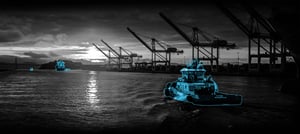To help you get started, we've tried to answer any questions you may have. Is your question not listed? Please contact us!
General Questions
Seagull makes you see what you’re missing. Conventional vessel detection systems such as AIS and radar have blindspots when it comes to the detection of pleasure craft or ships that wish to evade detection. Using Seagull to analyze camera footage and register all vessel traffic continuously can help to fill these blind spots.
Privacy & Security
Seagull stores three types of data:
- Organization data such as company details and preferences
- User data
- Logbook data such as anonymized images and vessel registration information
There are multiple options to protect camera streams that we support:
- You can whitelist the IP address of the Seagull app to allow it to access the camera streams. This ensures that other applications without whitelisted IP addresses won’t have access to the camera streams.
- A VPN connection can be set up if you wish to protect your camera streams further. Please reach out to our customer support at support@seagullsurveillance.com for more information so we can arrange a discussion between our network engineer and your IT department.
Getting started
Since Seagull is a cloud application, installing Seagull on your computer is not required. To open Seagull, open your browser and navigate to: yourorganization.seagullsurveillance.com. You can now log in and start setting up Seagull.
In order to be able to do speed measurements of passing vessels and combine data of multiple cameras into a unique logbook, Seagull requires to know the GPS coordinates of the field of view of the camera. To calibrate the camera, we ask you to:
- Match points in the camera frame with points on the map.
- Draw a line through the entire width of the entry or exit of the area.
- Indicate the direction.
Here, you will be able to:
- Add or remove users
- Assign user roles
Subscriptions
To sign up for Seagull:
- Fill out the subscription form (link) to get your subscription directly. Our financial department will get in touch and send you an invoice.
- Get in touch with our sales department (here) if you’d like to discuss the options before signing up.
You can pay for your subscription by invoice, either monthly or annually. When you choose the yearly payment option a discount will be applied. You will receive an invoice through email with a 14-day payment term.
For cancellations or changes to your subscription, please contact us via invoices@seagullsurveillance.com. You may cancel at any time with a 30-day notice. A cancellation does not prohibit you from subscribing again in the future.
The Product
Seagull can currently be integrated with other systems through its API. Of course, we’re open to discussing options in special cases. For more information, please reach out to our support department at support@seagullsurveillance.com.
Seagull is currently able to detect 20 different vessel types, split into seven vessel categories. We continuously update Seagull’s vessel detection capabilities and will therefore keep expanding this taxonomy.
The following vessel types are supported:
- Cargo vessels
- Tankers
- Passenger vessels
- Ferry
- Cruise ship
- High-speed craft
- Fast ferry
- Tugs and special craft
- Military
- Offshore
- Patrol vessel
- Tug
- Supply tender
- Fishing vessel
- Pleasure craft
- Sailing vessels
- Tall ships
- Sailing boat
- Sailing yacht
- Motor vessels
- Superyacht
- Motorboat
- Motor yacht
- RIB
- Jet ski
- Rowing boat
To recognize vessels, Seagull analyses camera footage with machine learning. By providing a large number of examples of each vessel type, Seagull has learned to find patterns in the characteristics of each vessel type, such as shape, color, size, and other visual identifiers. Over time, Seagull has learned to recognize these vessel types in the new camera footage.
If you have connected more than one camera to Seagull, the logbook information of both cameras will be combined in the Main overview. Through GPS-based multi-camera tracking, vessels can be followed through multiple cameras, which ensures that the Main overview only displays each vessel once.
As a rule of thumb, it can be said that if a human is able to recognize a vessel in the camera footage, Seagull will be able to do so too.
Seagull can’t see what isn’t visible. When the view of a camera is completely blocked by mist, heavy rain, or snow, Seagull will not be able to recognize vessels.
With that being said, Seagull is able to handle most rainy or misty conditions (see example).
The vessel speed that Seagull measures is meant to serve as an indication of relative speed throughout the area, which can be used for alerts. The speed measurement is highly dependent on the accuracy of the GPS calibration of the camera, which can cause inaccurate measurements. Therefore, the measurement is not meant to be used for law enforcement purposes.
Seagull allows users to set the conditions they wish to receive alerts. Currently, these conditions are:
- The time of registration
- The speed of the vessel
A sound will play in the browser to alert the operator for every new registration that matches the criteria.
- A report
- A total count graph
- A trends graph
- The content of the logbook can be downloaded as .csv file.
- The images belonging to registrations can be downloaded in .jpg format.
